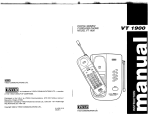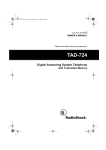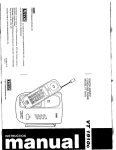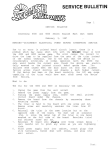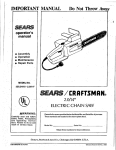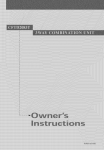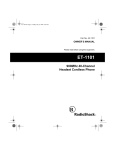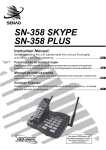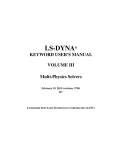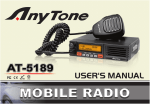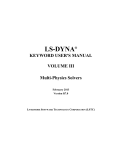Download VTech VT2900 Specifications
Transcript
DlGlTAL 900MHZ 2 LINE CORDLESS PHONE MODEL VT2900 WEiI VTECH COMMUNICATIONS LTD. Distributed in the U S A . by VTECH Communications, 8770 SW Nimbus Avenue / Beaverton, Oregon, 97008 Distributed in Canada by VTECH Electronics Canada Ltd., Suite 200 - 7671 Alderbridge Way Richmond, B.C. V6X 1Z9. Copyright 1996 for VTECH COMMUNICATIONS LTD. ISSUE 0 VTECH COMMUNICATIONS LTD. TABLE OF CONTENTS ................................... . . INTRODUCTION 1 Parts Check List ..................... ............2 REPLACING THE BATTERIES 3 Charging the handset batteries ...........3 Replacing The Handset Batteries .........4 IMPORTANT SAFETY INSTRUCTIONS.5 GETTING STARTED.............................7 Disconnecting ..................................... 17 OFF Mode (STANDBY) ......................17 Volume Controls .................................. 17 Using the Speakerphone ....................18 To Put A Call On Hold ........................18 .....................7 AC Power Adapter ............................... 7 Modular Jack Test ................................ 8 Ringer Switches .................................... 8 Switching to the Handset ........................ 20 ........... Setting Up Your VT2900 Setting the Tone/Pulse Switch .............8 Wall Mounting ..................................... 10 THE LCD DISPLAY ............................ 12 ..................13 KEYPAD ...................14 I f Joining a Handset Conversation ........20 FLASH .................................................... 20 REDlAL .................................................. 20 ADVANCED FUNCTIONS 21 .................. Conferencing ....................................... 21 Temporary Tones ................................. 22 ....................23 THE BASESET Changing Ringer Tones ......................23 QUICK REFERENCE GUIDE ............15 Turning Off The Ringer .......................23 SET-UP ............................................... 15 Checking The Ringer Type .................23 MAKING CALLS ................................. 15 PROG and CLEAR Functions ............23 ANSWERING CALLS ......................... 15 Advanced Dialing .............................. 24 15 Changing Channels ............................. HANGING UP ..................................... 24 TO PLACE A CALL ON HOLD ..........15 MEMORY DIALING ............................25 TO MUTE A CALL WHILE YOU ARE ON Dialing using Location ........................ 25 SPEAKERPHONE................................ 15 DELETE THIS LINE ...........................25 TO CONFERENCE TWO CALLS ......15 Storing .................................................. 25 USING THE INTERCOM ...................15 Dialing Using Name ............................ 27 PROGRAMMING MEMORY................15 Changing Stored Numbers .................27 NAME DIALING: ................................. 16 Deleting Stored Numbers ...................27 NUMBER DIALING: ............................ 16 Storing Special Codes ........................27 USING REDIAL ................................... 16 MAINTENANCE .................................. 28 HOLD .................................................. 16 OUT OF RANGE INDICATION ............29 CHANGING CHANNELS .................... 16 IN CASE OF DIFFICULTY .................... 30 FLASH ................................................. 16 VTECH Limited Warranty ...................32 CLEARING THE DISPLAY .................16 FCC and IC Regulations ....................33 THE HANDSET KEYPAD ; The Mute Features............................... 19 Using Both Lines At Once ..................19 ........................... BASIC OPERATION 17 Making Calls ....................................... 17 Programming The Ringer TECHNICAL SPECIFICATIONS .........36 INTRODUCTION Congratulations! You have purchased one of the most sophisticated cordless telephones on the market! The VT2900 has been designed to offer a new standard in cordless telephone technology. Unlike most other cordless phones, the VT2900 digitizes your voice to give the minimum amount of noise. In most conditions you will not be able to tell you are using a cordless phone. Gone are the annoyances of static, interference and having to listen to other people's conversations on your cordless phone. The VT2900 scrambles your voice before it transmits it. This allows you the security of knowing that no one can tune in and eavesdrop on your conversations. The phone will also INTRODUCTION alert you when you are "Out of Range" even when you're not using the phone! In this way you will not miss an incoming call just because you were not close enough to the base unit. n - - This manual is designed to make you familiar with the VT2900. We strongly recommend you read the manual before using your phone. VOLUME CONTROL KEYS FLEXIBLE ANTENNA LCD SCREEN LlNE KEYS Other special features are: Two Line Operation Liquid Crystal Display on Handset 20 Number Speed Dial Memory "Name" Dialing 10 Channels of operation Automatic Channel Selection 65,000 security code combinations Page/lntercom HOLD, REDIAL and CONFERENCE features Programmable Ringer Types Digital Volume Adjust Handset Volume Adjust OFF KEY DIGIT KEYS ZERO *.TEMPORARY TONE PROGRAM AND MEMORY KEY CLEAR KEY INTERCOM 8 CHANNEL CHANGE KEY CONFERENCE AND BACKSPACE KEY Parts Check List: 1. Base unit, Handset and AC adapter 2. One-Line Telephone Cord (clear plugs) 3. Two-Line Telephone Line Cord (black plugs) 4. Battery Pack 5. Mounting screws for wall mounting 6. Wall mount accessory REDIAL KEY HOLD KEY MAlN FEATURES ON HANDSET PARTS INCLUDED PHONE CORD JACKS \ \ MAlN FEATURES ON BASE UNlT MEMORY DIALING CARD SPEAKER GRILL LlNE 2 RINGER ONIOFF SWITCH LlNE 1 RINGER ONIOFF SWITCH TONEIPULSE SWITCH ANTENNA OFF KEY LlNE KEYS VOLUME UPIDOWN KEYS CONFERENCE KEY HOLD KEY INTERCOM KEY MUTE KEY POWER INDICATOR CHARGE INDICATOR CHARGE CONTACTS HANDSET WALL MOUNTING BRACKET BASE UNIT SCREW CAPS WALL MOUNTING SCREWS AC ADAPTER E A T E R Y PACK REPLACING THE BATTERIES Charging the handset batteries The handset of your VT2900 cordless telephone is powered by rechargeable batteries. They charge automatically whenever the handset is in the base. You should charge the batteries for 24 hours when you first receive your phone. You'll know the batteries need charging when: The phone emits a dual-tone warning when you press the LINE or INTCM keys. The battery symbol is flashing. The handset seems completely dead, the LCD is completely clear and the handset does not beep when you press the keys. To Charge The Batteries To charge the batteries, place the handset in the base unit. The CHARGE indicator will light to show the handset is seated properly and the batteries are charging. The CHARGE indicator will flash if the handset battery is not charged enough for the handset to operate. Once the battery REPLACING THE BATTERIES reaches the minimum level needed to operate, the CHARGE indicator will illuminate steadily and the battery will continue to charge up to its full potential. It is recommended that the battery be charged for 24 hours during the initial charge. After this initial charging, an overnight charge of 8 to 10 hours should be sufficient to fully charge the battery. You can use your telephone before that with diminished capacity, but it is best to let them charge fully. To maximize the charge capacity of the NiCad battery pack, recharge the battery for several cycles. The meximum battery life between charges is 5.5 hours of continuous talk time or 6 days of standby. I IT'S IMPOSSIBLE TO OVERCHARGE THE BATTERIES If the Batteries Don't Recharge The battery pack can be recharged many, many times but if you get a low-battery signal even after 24 hours of charging, the battery pack should be replaced. To purchase replacement battery packs, call VTECH Cornmunications at 1-800-624-5688. In Canada, call VTECH Electronics at 604-273-5131. Replacing The Handset Batteries Follow the steps below: 1. Remove the battery case by pressing down on the release tab above the battery and then sliding the batten/ downward. t CAUTION: To Reduce the Risk of Fire or Injury to Persons, Read and Follow the Instructions 1. Use only VTECH battery. 2. Do not dispose of the battery in a fire. The cell may explode. IMPORTANT : Do not dispose of this battery into household garbage. For information on recycling or proper disposal,~consultyour local solid waste collection or disposal organization. 3. Do not open or mutilate the battery. Released electrolyte is corrosive and may cause damage to the eyes or skin. It may be toxic if swallowed. I I BATTERY CONNECTION 2. Discard the old battery pack. Don't put the old battery pack in a trash compactor or a fire - it could burst. 3. Slide the new battery pack on its track up until it is firmly in place. 4. The new battery pack must be charged before using your telephone. Place the handset in the cradle of the base unit to allow it to charge for 24 hours. 4. Exercise care in handling batteries in order not to short the battery with conducting materials such as rings, bracelets, and keys. The battery or conductor may overheat and cause burns. IMPORTANT SAFETY INSTRUCTIONS When using your telephone equipment, basic safety precautions should always be followed to reduce the risk of fire, electric shock and injury to persons, including the following: 1 . R e a d and understand all instructions. 2. Follow all warnings and instructions marked on the product. 3. Unplug this product from the wall outlet before cleaning. Do not use liquid cleaners or aerosol cleaners. Use a damp cloth for cleaning. 4. Do not use this product near water (for example, near a bath tub, kitchen sink, or swimming pool). 5. Do not place this product on an unstable cart, stand, or table. The product may fall, causing serious damage to the product. 6. Slots and openings in the cabinet and the back or bottom are provided for ventilation. To protect it from overheating, these openings must not be blocked by placing the product on the bed, sofa, rug, or other similar surface. This product should never be placed near or over a radiator or heat register. This product should not be placed in a built-in installation where proper ventilation is not provided. 7. This product should be operated only from the type of power source indicated on the marking label. If you are not sure of the type of power supply to your home, consult your dealer or local power company. 8. Do not allow anything to rest on the power cord. Do not locate this product where the cord will be abused by persons walking on it. 9. Never push objects of any kind into this product through cabinet slots as they may. touch dangerous voltage points .or short out parts that could result in a risk of fire or electric shock. Never spill liquid of any kind on the product. 10.To reduce the risk of electric shock, do not disassemble this product, but take it to a qualified serviceman when some service or repair work is required. Opening or removing cabirlet parts other than specified access doors may expose you to dangerous voltages or other risks. Incorrect reassembling can cause electric shock when the appliance is subsequently used. 11.Do not overload wall outlets and extension Cords as this can result in the risk of fire or electric shock. IMPORTANT SAFETY INSTRUCTIONS 12.Unplug this product from the wall outlet and refer servicing to qualified service personnel under the following conditions: A. When the power supply cord or plug is damaged or frayed. 13.Avoid using a telephone (other than a cordless type) during an electrical storm. There may be a remote risk of electric shock from lighting. 14.Do not use the telephone to report a gas leak in the vicinity of the leak. B. If liquid has been spilled into the product. C. If the product has been exposed to rain or water. D. If the product does not operate normally by following the operating instructions. Adjust only those controls that are covered by the operating instructions because improper adjustment of other controls may result in damage and will often require extensive work by a qualified technician to restore the product to normal operation. E. If the product has been dropped and the cabinet has been damaged. F. If the product exhibits a distinct change in performance. SAVE THESE INSTRUCTIONS GETTING STARTED Setting Up Your VT2900 1. Choose an area near an electrical outlet and a telephone wall jack. 2. Connect your telephone Line Cord(s). If you know what types of telephone jacks you have, proceed with the appropriate steps below. If you are not sure whether you have two-line jacks or one-line, perform the Modular Jack Test on page 8. If you have two telephone lines installed on a single jack (type RJ-14), use the two line cord supplied with your phone (the one with the black plugs at each end). On the base, plug one end of the cord into the jack marked "L1 OR L l l L 2 . Plug the other end into the two-line jack in your wall. Now proceed to page 8 Modular Jack Test. GETTING STARTED If you have two telephone numbers installed on two separate jacks, (type RJ-11) both jacks must be within reach of your phone. You will need to use both line cords supplied (the one with the clear plugs and the one with the black plugs). On the base unit, plug one of the line cords into the jack marked "L1 or L1/ L2". Plug the other end of the cord into the wall jack that you want designated as LlNE 1 on your phone. Plug the other line into the jack on the base unit marked "L2. Plug the other end of the cord into your other wall jack. The line in this jack will be LINE 2 on your telephone. Modular Jack Test Perform this test if you aren't sure whether you have two-line jacks or single-line jacks. If you already know which types of jacks you have, skip this test and proceed on to the next section. To test a jack. 1 Use the telephone line cord with the black plugs supplied with this phone. Plug one end in the base "L1 or LIlL2". Plug the other line into the wall jack you want to test. 2. Plug the AC adapter into a standard electrical outlet and connect the DC plug into the telephone base. If you don't hear any dial tone on a jack, there may be a problem with the jack or the wiring in your home. (see page 30, 'IN CASE OF DIFFICULTY'). Ringer Switches If you want both telephone lines to ring when calls come in, set both switches on the base to ON. If you want to turn off the ring for one or both lines set the appropriate switch or switches to OFF. When a ringer switch is set to OFF, the ringer tone for that line is turned off at the base.This does not affect the handset ringer (see page 23, Programming the Ringer). AC Power Adapter Plug the AC power adapter into an electrical outlet. Note: For two-line operation, you must have two telephone lines (with two telephone numbers) installed by your local telephone company. If you have only one telephone line, this phone will still operate, but only as a single line phone. 3. On the base unit, press LlNE 1 and release it. You should hear a dial tone over the speaker. Adjust the volume control to a suitable setting if necessary. 4. Press OFF, and the dial tone will stop. Setting the Tone/Pulse Switch Set the TONEIPULSE switch on the base unit. If you have touch tone service on both you phone lines, set the switch to TONE. If you have rotary (Pulse) service on either of the phone lines, set the switch to PULSE. 5. Now press LlNE 2 and release it. If you hear a dial tone over the speaker, it means there are two lines coming from that one jack. You cannot connect this ~ h 0 n eto a two-line jack and a single:line jack at the same time. You can only connect it to two single line jacks, or to one two-line jack. AC ELECTRICAL OUTLET TELEPHONE WALL JACK If you don't hear a dial tone, it means the jack has only one line. Follow the steps above for each jack you want to test. When you've determined which types of jacks you have, connect your line cords as described in the previous section. TONEPULSE SELECTOR LINE 1 RINGER ONIOFF SWITCH LlNE 2 RINGER ONIOFF SWITCH GETTING STARTED WALL MOUNTING You cannot select TONE for one line and PULSE for the other. Both will be either TONE or PULSE. CAUTION: 1. Never install telephone wiring during a lightning storm. CHARGE THE HANDSET BAlTERY PACK BEFORE USE. The battery pack recharges automatically whenever the handset is in the base unit. The batteries must be charged for 24 hours before using your phone for the first time. 2. Never install telephone jacks in wet locations unless the jack is specifically designed for wet locations. Fill in the telephone number card on the base unit. To remove the window, insert the tip of a paper clip or pen into the hole, and gently flex the window. Check for a dial tone. After the batteries are charged, pick up the handset. Now press LlNE 1 on the handset. The LlNE 1 indicator should light up on the LCD, and you should hear a dial tone. If not, see 'IN CASE OF DIFFICULTY' on page 30. 3. Never touch uninsulated telephone wires or terminals unless the telephone line has been disconnected at the network interface. 4. Use caution when installing or modifying telephone lines. WALL INSTALLATION USING MOUNTING SCREWS PROVIDED Tools You Will Need: A hammer, a nail, a pencil or ballpoint pen, a Phillips head (+) screwdriver, and the Wall Mounting Template included in the back of this booklet. 1. Choose a spot near an electrical outlet and a telephone jack. Your phone requires a modular telephone jack and a standard electrical outlet (120v AC). The power cord is six feet long; make sure there is an electrical outlet within reach of the base. The outlet should not be controlled by a wall switch. If the switch is ever turned off, the phone will not operate. 2. Choose and mark the mounting position. The mounting screws should screw into a wooden stud within the wallthey will not hold securely in wallboard alone. Locate a wall stud in the area where you want to install your telephone. Use the Wall Mounting Template and a pencil to mark the screw positions on the wall over the stud (Figure 1). Put the template aside. 3. Install the mounting sleeves and screws. Start the screw holes by lightly tapping a nail into the marks you made on the wall. Remove the nail from the wall. Now slip the mounting sleeves onto the screws as shown, with the smaller end of the sleeve Figure 1 Figure 2 toward the screw head. Insert the screws into the holes you started. Tighten the screws until the large end of the mounting sleeve is flat against the wall (Figure 2). WALL MOUNTING THE LCD DISPLAY 4. Position the wall mount adapter on the base. Line up the tabs on the wall mount adapter with the holes on the bottom of the base (Figure 1). Snap the wall mount adapter firmly in place. 1 I i I I I 5. Mount the base on the wall. Position the base so the mounting studs will fit into the holes on the bottom of the base. Position the power cord to extend down the wall the phone is to be mounted on. Slide the base down on the mounting studs until it locks into place. Line 2 Indicator INTERCOM Indicator Line 1 l n d i c a t o r 7 7 Low Battery Indicator \ \ I /-- Memory Mode Indicator Name Dialing Indicator 7 Earpiece Volume Level Indicator PROGRAM lndicator LOW BATTERY lndicator Flashes when the unit is in a lowbattery condition.The handset typically operates for at least 5 minutes after the low battery indication is given. If PHONE or INT.COM is pressed during a low battery condition, a warning tone is also generated. .Figure 1 6. Connect the telephone line cord. The telephone line cord has a snap-in plug at each end. lnsert one of the plugs into the jack on the bottom of the base. Insert the other end of the plug into the wall jack. nn A A LINE1 LINE2 Indicators illuminate when the line(s) is active. If the line(s) is occupied by the base, the indicator (s) will flash slowly; if the line(s) is on hold, the indicator(s) flash quickly. 7. Plug the ac adapter on the power cord into an electrical outlet (Figure 2). 8. Set the Dial Mode switch on the base unit. If you have touch tone service on your phone line, set the switch to TONE. If you have rotary service, set the switch to PULSE (Figure 3). 7 ,- [m)INTERCOM lndicator illuminates when an intercom link has been set-up between base and handset. Figure 2 [m) MEMORY Indicator illuminates when the unit is in memory dialing mode. LlNE 2 RINGER ONlOFF SWITCH LlNE 1 RINGER OWOFF SWITCH TONEPULSE SELECTOR Figure 3 . (NAME) NAME ndicator illuminates when the unit is in memory name dialing mode. 4 ) )) VOLUME lndicator shows the handset volume setting. This indicator is always on provided the handset battery has sufficient charge. If this indicator is not on, the handset will not function. ( PROGRAM Indicator illuminates when the unit is in program mode. The name indicator will also illuminate for name programming. THE HANDSET KEYPAD I THE BASESET KEYPAD 2 LINE M H z CORDLESS PHONE FLEXIBLE ANTENNA bmzl \. w LCD SCREEN / LINE KEYS MEMORY DIALING CARD SPEAKER GRILL -- ANTENNA OFF KEY OFF KEY DIGIT KEYS LINE KEYS ZERO VOLUME UPIDOWN KEYS >f: , TEMPORARY TONE PROGRAM AND MEMORY KEY CLEAR KEY CONFERENCE KEY INTERCOM & CHANNEL CHANGE KEY INTERCOM KEY MUTE KEY CONFERENCE AND BACKSPACE KEY HOLD KEY REDIAL KEY POWER INDICATOR HOLD KEY CHARGE INDICATOR \ MAlN FEATURES ON HANDSET \ CHARGE CONTACTS MAlN FEATURES ON BASE UNIT QUICK REFERENCE GUIDE Here's a brief guide to the features and functions of your VT2900cordless telephone: SET-UP Connect telephone line cord(s) to base unit and telephone jack(s). (Page 7) Plug AC adapter into a standard electrical outlet. (Page 7) Set Dial Mode switch to PULSE or TONE. (Page 8) Set Base Ringer switches to ON. (Page 8 ) Let handset batteries charge for 24 hours before first use. (Page 3) MAKING CALLS Press a LlNE key button on the handset. When the LlNE indicator lights and you hear a dial tone, dial the number. ANSWERING CALLS To answer a call on the handset, press the LlNE key of the ringing line. The handset will not autoanswer when lifted off the base cradle. To answer a call on the base, press the LlNE key of the ringing line. HANGING UP For the handset, press OFF or place. the handset in the base cradle. For the base, press OFF. TO PLACE A CALL ON HOLD Press HOLD on the handset or base. Press the appropriate LlNE key to return to the call. TO MUTE A CALL WHILE YOU ARE ON SPEAKERPHONE Press MUTE on the base. The MUTE indicator will light and the speakerphone microphone will be cut off. Press MUTE again to return to normal speakerphone operation. TO CONFERENCE TWO CALLS At least one of the calls must be on hold. Press CONF to conference the calls. This can be done on base (using speakerphone) or handset. USING THE INTERCOM From the handset, press INTCM to signal the person at the base unit. he base unit will ring once and then the intercom will be automatically activate. The person at the base then speaks toward the microphone-just like using the speakerphone. To page from the base, press INTCM. The person at the handset presses INTCM to activate the intercom. To end an intercom conversation, press OFF. To use intercom during a telephone conversation, put the active line on HOLD, then press INTCM (on the base) or INTCM (on the handset). PROGRAMMING MEMORY The phone should be OFF. Enter the number you wish to store on the LCD. Press and hold the MEMIPROG key until the PROG indicator turns on. Enter the two digit memory location (00 .. 19), the NAME indicator will then turn on. Enter the six character name and press MEM to store or simply press MEM to bypass name programming and store the number. QUICK REFERENCE GUIDE NAME DIALING: Press a LlNE key. Press MEM. Make sure NAME is displayed on the LCD. If not, press MEM again. Begin entering the name you wish to dial. As soon as there is a match, the number will appear on the screen and will be dialed out. NUMBER DIALING: Press a LlNE key. Press MEM. Make sure NAME is NOT displayed on the LCD. If it is, press MEM again. Enter the memorv location of the number you wis(to dial (00..19). The number will be displayed on the LCD and will be dialed out. USING REDIAL Press a LINE key, then REDIAL to automatically redial out the last number you dialed on either line. HOLD When using the handset or speakerphone, press HOLD to put a call on hold. To return to the call, press the held LINE key. CHANGING CHANNELS Press the CHANIINTCM key to change the channel. The display will briefly show the new channel number. FLASH You can use your VT2900 cordless telephone with services such as Call Waiting and Call Forwarding. Instead of pressing the switchhook, press the LINE key of the line you are talking on. After pressing the line key, wait 2 seconds or check that a dial tone is present before dialing. CLEARING THE DISPLAY The display can be cleared by pressing and holding the CLEAR key for about a second until the display clears. BASIC OPERATION Making Calls You can make calls directly from the handset whether you are at the base or away from it. You cannot make calls on the speakerphone in the base but you can answer calls from the base. From the handset Pick up the handset and press a LlNE key. When you hear a dial tone, dial the number. The LlNE indicator for the line you are using will turn on. TO MAKE A CALL PRESS A LlNE KEY, EITHER LlNE 1 OR LlNE 2 PRESS OFF IF YOU MAKE A MISTAKE WHEN DIALING. OR TO HANG UP. NOTE: There are two different ways to dial out a number: 1. Press the LlNE key and wait for a dial tone. Then dial out the number you want. 2. Enter the number onto the display first, then press the LlNE key. This will dial out the number that is displayed on the LCD after 2 seconds. (See Advanced Dialing on page 24). If you make a mistake when dialing, press OFF to hang up, then press the LlNE key and wait 2 seconds to get a dial tone again. BASIC OPERATION Disconnecting To end a call, either place the handset back in the base, or press OFF on the handset. OFF Mode (STANDBY) When the unit is OFF the display will be clear except for earpiece volume indicator. If the screen is completely blank it means that the battery is not connected or has insufficient charge to operate the handset. Place the unit in the base to recharge the battery. The base charge indicator will stop flashing when the handset battery has received the minimum charge necessary to operate. Volume Controls Both the base unit and the handset have digital volume controls. The volume controls for the speakerphone are located on the front face of the base unit. Press the volume up side to increase the speaker volume and the volume down side to decrease the volume. Holding either side down will continuously change the volume setting at the rate of 4 steps per second on the base and 2 steps per second on the handset. The volume controls for the handset are located on the side of the unit. Press the A (up) or (down) keys to increase or decrease the volume. Holding either key down will continuously change the volume setting. The ear piece volume level indicator will change accordingly. V VOLUME CONTROL KEYS . . TO END A CALL FROM THE BASE PRESS OFF To Put A Call On Hold While using the speakerphone or the handset, you can put a call on hold by pressing HOLD. The hold indicator on the base unit will flash to show that a call is on hold. Using the Speakerphone You cannot make calls from the speakerphone. However, you can answer calls from the speakerphone by pressing the LlNE key for the incoming call. It does not matter whether or not the handset is in the base - you can use the speakerphone in either case. To end a call on the speakerphone, press OFF. VOLUME UPIDOWN CONTROL TO ANSWER A CALL FROM THE BASE PRESS LlNE 1 OR LlNE 2 FOR THE INCOMING CALL On the handset, the LlNE indicator will flash quickly to show that the line is on hold. To return to the call, Dress the LlNE key on the handset o; the base. BASIC OPERATION BASIC OPERATION If a call is on HOLD using the VT2900 and you pick up another phone on the same line, the VT2900 will take itself off HOLD and turn OFF. Therefore, you do not have to go back to turn the phone OFF if you go to another extension. It is done automatically. Using Both Lines At Once If your using your handset to carry on a conversation on one line, it is possible to use the other line to answer a call, make a call or use the intercom - all without disconnecting your first call. The Mute Feature When you press MUTE while using the speakerphone, you can hear the caller's voice, but they can't hear you. Use this feature to speak to someone in the room without your caller hearing. While the call is muted, the MUTE indicator will be lit. To go back to the two-way conversation, press MUTE again. If someone is using the speakerphone or another extension to talk on one line, you can still use the handset to make or answer calls on the other line. This feature is also helpful when using the speakerphone in a noisy room. (Loud background noise can prevent your caller's voice from coming over the speaker). Press MUTE while your caller is speaking. Press MUTE again when you are ready to speak. You can also link both lines together to have a three or four-way conversation. See Conferencing on page 21. If you press HOLD to place a call on hold, you can use the other line as if it were a second phone. For example, if the second line rings when you are on a call, press HOLD to put the first call on hold. Press the LlNE key of the incoming call. To switch back to your original call, press the LlNE key of the original call which is on hold. To hang up the second call but still keep the first call on hold, simply press OFF. You can also place the second call on hold and return to the first. Just press the LlNE key of the original call, the other call will automatically be put on hold. This is same as pressing HOLD, then the LlNE key. NOTE: If you want to switch to another line without disconnecting your current call, you can also simply press the other line. This will automatically put your first call on HOLD and connect you to the second call. The only way to disconnect a call is to have the call active and press OFF. Switching to the Handset If the handset is in the base, vou can switch from the base by picking up the handset and pressing the appropriate LlNE key. Press OFF on the base unit to disconnect it from the conversation. To switch back to the speakerphone, you must first press the appropriate LlNE key on the base, press OFF on the handset, then place the handset back in the cradle. NOTE: You cannot switch back to the speakerphone just by returning the handset to the base - that will disconnect the call. - - - -- Joining a Handset Conversation If someone is speaking on the handset, you can join the conversation on the speakerphone. Just press the appropriate LlNE key on the base unit. This is just like picking up an extension. Either party can then leave the conversation by pressing OFF. Likewise, if you are using the speakerphone, someone at the handset can join the conversation by pressing the appropriate LlNE key on the handset, then leave by pressing OFF. The call will remain connected as long as either the handset or the speakerphone remains on the line. (To disconnect the call, both the handset and the base unit must hang UP.) FLASH You can use your VT2900 cordless phone with services such as Call Waiting and Call Forwarding. Instead of pressing the switch-hook (as you would on a regular phone) press the LlNE key of the line you are talking on. This feature is not available during conference calls. When flashing the line in order to dial a new number, wait 2 seconds or check that dial tone is present before dialing. REDIAL To REDIAL the last number you dialed out, press a LlNE key then press REDIAL. The phone will automatically dial out the number. The number will be shown on the display. ADVANCED FUNCTIONS Conferencing This feature allows you to link both lines together to hold a three-way conversation between you and the parties on LINES 1 and 2. You can also hold a four-way conversation between yourself, a person on the speakerphone, and LINES 1 and 2. You can hold a conference call at either the handset or the base. However, only the handset can dial out calls To establish a conference call at the handset: 1. Dial one party on one of your lines. After you are connected, press HOLD. 2. Press the other LlNE button and dial the second party. 3. When the second call is established, press CONF to bring both parties into the conversation. Both LINE indicators on the display will be on while the three parties are connected. NOTE: Press CONF to link any two calls that are both on hold, whether you called them or they called you. ADVANCED FUNCTIONS . CONFERENCE CALLING FROM THE HANDSET MAKE OR RECEIVE CALL ON LlNE 1 OR LlNE 2 PRESS HOLD TO PLACE THIS CALL ON HOLD MAKE OR RECEIVE ANOTHER CALL ON THE OTHER LINE. PRESS CNFIBSP TO BRING BOTH PARTIES INTO THE CONVERSATION Conference calls on the speakerphone: If you are using the speakerphone and a second call comes in, put the first call on hold and press the LlNE button to answer the second call. You can now press CONF and have a conference call with both lines if you wish. To switch a conference call from the handset to the base, press LlNE 1 or LlNE 2 on the speakerphone and then press OFF on the handset. To switch a conference call from the base to the handset, press LlNE 1 or LlNE 2 on the handset and then press OFF on the base. Alternately, you can also put both the calls on hold by pressing the HOLD key and then pressing the CONF key on the end where you wish to pick up the call again. To join a three-way conference already in progress, press LlNE 1 or LlNE 2 on the base if the conference is at the handset. If the conference is at the base, press LlNE 1 or LlNE 2 at the handset. CONFERENCE CALLING FROM THE BASE If you are using the speakerphone and a second call comes in, put the first call on HOLD and press either LlNE 1 or LlNE 2 to answer the second call. You can now press CONF to bring both parties into Ihe conversation. To end a conference call: If you wish to end a conference call with one of the parties, press the LlNE key of the call you wish to discontinue. This will put the other line on HOLD. Press OFF to disconnect the active line. Press the LlNE key of the line you wish to continue talking to. 2. Press CONF to continue your conference call. Temporary Tone If you have a rotary (dial-pulse) telephone service, (TONEIPULSE switch is set to PULSE), this feature allows you to enter special codes and tones to operate answering machines, use electronic banking services, calling cards, or other special services. First, dial the call normally. Then activate the Temporary Tone feature by pressing TONE (the * key). You can then press the numbers or symbols you need, and your phone will send the proper signals. To end the call, press OFF or place the handset back in the base. The phone will automatically go back to rotary (dial-pulse) service. If you have touch-tone service, (TONE/ PULSE switch set to TONE), just enter the codes normally. This feature is only for touch tone service telephone lines. To end the entire conference call and disconnect all parties, press OFF while both lines are active. To put a conference call on hold: Press HOLD to hold both lines. Press CONF to release the hold and continue your conference call. To talk privately with one caller: 1. Press the LINE key of the person you want to speak with privately. This will automatically put the other call on HOLD. 1 Ir PRESS TONE (the ' key) ADVANCED FUNCTIONS Programming The Ringer The handset ringer is capable of four different types of ringer tones for each line. The following sections detail how to change the different tones and to turn off a ringer on the handset. Changing Ringer Tones To program, the handset must be OFF. To select a different ringer type do the following: Press and hold PROG until the PROG symbol appears on the display. Press the # key. Press: 1 for Handset LlNE 1 2 for Handset LlNE 2 3 for Baseset LlNE 1 4 for Baseset LlNE 2 ringer. The LCD will show what ringer is being programmed. I PROG I Press 1,2,3 or 4 to select a ringer type. Press MEM or OFF to store. PROGRAMMING THE RINGER TYPE HANDSET MUST BE OFF PRESS AND HOLD PROG UNTILTHE PROG SYMBOLAPPEARS ON THE DISPLAY 3 for Baseset LlNE 1 4 for Baseset LINE 2 PRESS 1 2 3 or 4 TO SELECT^ ~ ~ N G ETYPE R PRESS MEM or OFF TO STORE THE RINGER Turning Off The Ringer To turn off the ringer for a particular line do the following: Press and hold PROG until the PROG symbol appears on the display Press the # key Press 1 for Handset LlNE 1 ringer, 2 for Handset LlNE 2 ringer. Press 5 to turn off the ringer Press MEM or OFF to store.The base ringers are controlled by ONIOFF switches. Checking The Ringer Type To test the present ringer type for a particular line do the following: Press and hold PROG until the PROG symbol appears on the display Press the # key Press 1 for Handset LlNE 1 ringer, 2 for Handset CINE 2 ringer, 3 for Base LlNE 1 ringer, or 4 for Base LlNE 2 ringer Press 0 to test the ringer Press MEM or OFF to exit PROG and CLEAR Functions The PROG and CLEAR functions can be accessed by pressing and holding the relevant key. For example, to clear the display, press and hold the CLEAR key for 2 seconds until the display is cleared. To enter program mode press and hold the MEM key for 2 seconds. ADVANCED FUNCTIONS Advanced Dialing There are two different ways to dial out a number: 1 Press the LlNE key and wait for a dial tone. Then dial out the number you want either manually, using MEMORY (MEM) dialing or using REDIAL. 2 Enter the number you wish to dial onto the display first. Then press the LlNE key. This will dial out the number which is displayed on the LCD. NOTE: The phone will dial out any number which is shown on the display. If you do not want to dial the number shown on the LCD, it can be changed by: Use the CNFIBSP key to backspace one digit for each keypress. Additional digit$ can be entered. Press a LlNE key to dial the new number. Press and hold CLEAR until the display is cleared, then dial normally. Press the OFF key to clear the display, then dial normally. Wait for the display to clear, then .press LlNE and enter the number you wish to dial. Changing Channels In the unlikely event you notice interference when using your handset, press the INTCMICHAN key to switch to another channel. The display will briefly show the new channel number. This has nothing to do with your two phone lines - only the radio link between the handset and base. If the noise continues, see 'IN CASE OF DIFFICULTY' on page 30. CHANGING CHANNELS In the unlikely event you notice interference when using your handset, press the INT.COM/CHAN key to switch to a new channel MEMORY DIALING MEMORY DIALING The VT2900 is capable of two modes of memory dialing. You can dial out by pressing the memory location (e.g. 15) or by entering the person's name (e.g. "BOB). We suggest that numbers be stored with the person's name to which the number belongs. When dialing out you can use either the person's name or the memory location. Use the MEM key to toggle between NAME dialing and LOCATION dialing. When you access the memory dialing option the NAME indicator will be on to indicate the phone is in NAME dialing mode. If the symbol is off, the phone is in LOCATION dialing mode. Once you have selected a mode, the phone will stay in that mode until it is changed by the user. Dialing using Location If you wish to dial out the number stored in a particular memory location (e.g. 15) then do the following: 1. Press the LlNE key to get a dial tone. 2. Press MEM. Check that the NAME symbol is not on the display. If it is on, press MEM again. 3. Enter the memory location you wish to dial out. E.g. 15. The number stored at that location will be shown on the display and will automatically be dialed out. The number stored in this location will be dialed out. You can also review the contents of the memory locations when you are not connected to a line. When the phone is OFF, press MEM and you can scroll through the memory locations by using the and # key. If you wish to dial out a number shown press a LINE key. The phone will exit MEMORY,mode and dial the number displayed. Otherwise, press OFF to exit MEMORY mode. Enter the memory location (00..19) you wish to store the number in. As soon as the second memory location digit is entered, the NAME indicator will turn on and 6 dashes will appear. If you do not wish to store a name with this number, simply press the MEM key. You should hear a "Happy Tone', if not the programming was in error, and you will need to repeat the process. * Storing To program a MEMORY location, do the following: With the phone in OFF mode, enter the telephone number you wish to store. (16 Digits Maximum). Enter program mode by pressing and holding the MEMIPROG key. The PROG and MEM indicators will appear in the display. Enter a six character name to store with the number. Use the letters on the keypad. For a space, you can use the 1 key. Example: 'PEGGY ' would be entered by pressing 7,3,4,4,9,1 (P-E-G-G-Y-SPACE). Each dash will change to an under score as the letters are entered. Press MEM to store and exit. A Happy tone will be generated if programming was successful. Otherwise, the unit will generate a sad tone and display: NOTE: The name MUST have six characters. If the name you wish to enter has less than six characters, use the space symbol to fill in the rest or use part of the person's last name. If the name you wish to enter is longer than six characters, just put in the first six characters. When you dial using NAME, you will usually not need to enter in all six characters. You will only need to enter in as many as needed for the handset to get a match. For example, if you have stored 'GARY R' and 'GARY J' in the memory then you will need to enter in all six characters before the phone can distinguish which you want. If you get Duplicate displayed during programming when you are entering the name there may be several causes. Check: 1. You may be already using the same name. 2. There may be a name which is using the same number sequence. For example, 'JENNY' and 'KENNY'. Enter another name and press MEM. MEMORY DIALING / I 1 If you get Error displayed during programming when you are entering the name, you may have entered too few or too many letters. Enter only six letters. Enter the six letter name again and press MEM. Dialing Using Name To dial out a number to which you have stored the name do the following: Press a LINE key to get a line Press MEM Make sure NAME appears on the display. If it does not, press MEM again. Begin entering the name you wish to dial. As soon as the phone finds a match it will dis~lav . - the number and dial it out. Changing Stored Numbers To change or replace a stored number simply enter the new number on the display and store it in the memory location you wish to change. MAINTENANCE Deleting Stored Numbers To delete a stored number from memory do the following: Press MEM. Check to make sure NAME is not displayed on the LCD. If press MEM again. Enter the memory location (00..19) or use the arrow keys and # to search the memory to be deleted. Press and hold CLEAR key until the word "ERASED" appears. Press OFF Key to exit. * NOTE: Stored numbers are retained in memory even if the base loses it power or the handset battery is removed. Storing Special Codes To insert a pause in a phone number, press HOLD at the appropriate point when entering the number on the LCD. This inserts a 2 second pause. A 'p' appears in the display to show the pause. For longer pauses, press HOLD two or more times. Each press makes the pause 2 seconds longer and is treated as a stored digit. If your phone is connected to a PBX you can store the PBX access number and a pause before the phone number. For example, to store 9-PAUSE-555-1 234 in memory location 08 (without NAME dialing), do the following: 1. Press 9 2. Press HOLD 3. Dial 5551234 4. Press and hold PROG 5. Enter 08 6. Press MEM ' L TAKING CARE OF YOUR TELEPHONE Your VT2900 cordless telephone contains sophisticated electronic parts so it must be treated with care. Avoid rough treatment Place the handset down gently. Save the original packing materials to protect your telephone if you ever need to ship it. Avoid water Your telephone can be damaged if it gets wet. Do not use the handset outdoors in the rain, or handle it with wet hands. Do not install your base unit near a sink, bathtub or shower. Remember that electrical appliances can cause serious injury if used when you are wet or standing in water. If your base unit should fall into water, DO NOT RETRIEVE IT UNTIL YOU UNPLUG THE POWER CORD AND TELEPHONE LINE CORDS FROM THE WALL. Then pull the unit out by the unplugged cords. Electrical storms Electricalstorms can sometimes cause power surges harmful to electronic equipment. For your own safety, use caution when using electric appliances during storms. Cleaning your telephone Your telephone has a durable plastic casing that should retain its luster for many years. Clean it only with a soft cloth slightly dampened with water or a mild soap. Do not use excess water or cleaning solvents of any kind. OUT OF RANGE INDICATION NOISE OR INTERFERENCE Your VT2900 cordless telephone has auto-channel scan circuitry which will detect excess noise and change the channel of the phone to reduce it. This is done automatically or manually by pressing the INT.COMICHAN key. Since the VT2900 is a fully digital phone it does not suffer from noise associated with regular cordless phones. At times you may experience occasional "drop outs" especially at the extreme edges of the phone's range. Simply move closer to the base unit and this will disappear. For out-of-range in standby mode, the handset will beep at 15 second intervals. To disable the warning tones, simply press and hold a number key until the phone gives a confirmation beep. OUT OF RANGE WHEN PHONE IS ON If you are presently engaged in a phone conversation move closer to the base. If the base unit does not communicate with the handset within 25 seconds of losing contact it will automatically hang up. AUTOMATIC SECURITY CODING Every time you place the handset in the base, your VT2900 phone randomly picks one of 65,000 possible security codes. This allows your handset and base to recognize each other, and minimizes the possibility of another cordless phone using your telephone line. OUT OF RANGE WHEN PHONE IS OFF If the phone is OFF, the handset and base still monitor each other to make sure that they can communicate. If the handset is moved out of range, the handset will make a series of beeps at 15-20 second intervals. This tells you that the handset may not ring for incoming calls. OUT OF RANGE INDICATION If the handset is moved to a point where the base and handset can no longer communicate, the handset will make a quick series of beeps to signal "Out of Range." If you wish to stop the "Out of Range" tones, simply press the OFF key on the handset. The handset will not work until the handset is brought closer to the base. The base unit will continue to function during this time. If the handset is active when taken out-of-range, it will beep twice a second and enter standby mode after 25 seconds if the link is not reestablished. If the handset is brought back within range, it will automatically re-link and the warning tones will stop. When the base unit is unplugged from the power supply, the handset will begin to give the "Out of Range" warning beeps. This will continue until the base is powered again and the handset is placed into the base cradle for re-initialization. IN CASE OF DIFFICULTY b If you have difficulty operating your phone, the suggestions below should solve the problem. If you still have difficulty after trying these suggestions, call VTECH Communications at 1-800-624-5688. In Canada, call VTECH Electionics at 604-273-5131. THE PHONE DOESN'T WORK AT ALL. Make sure the power cord is plugged in. Make sure the telephone line cord is plugged firmly into the base unit and the telephone wall jack. Make sure the batteries are properly charged. If the Battery indicator is on, the battery needs charging. If the display is completely blank, you must charge the batteries. NO DIAL TONE. First check all the suggestions above. Check the setup of your two line jacks. See page 9 test Modular Jack Test. If you still don't hear a dial tone, disconnect the base unit from the telephone jack and connect a different phone. If there is no dial tone on that phone either, the problem is in your wiring or local service. Call your local telephone company. YOU GET NOISE, STATIC, OR A WEAK SIGNAL EVEN WHEN YOU'RE NEAR THE BASE UNIT. Place the handset in the base momentarily to re-set the security code. Then press a LINE key to get a line. Household appliances plugged into the same circuit as the base unit can sometimes cause interference. Try moving the appliance or the base unit to another outlet. YOU GET NOISE, STATIC, OR A WEAK SIGNAL WHEN YOU'RE AWAY FROM THE BASE UNIT. You may be out of range. Either move close to the base, or relocate the base unit. The layout of your home may be limiting the range. Try moving the base unit to a new position in your home or office. THE HANDSET DOES NOT RING WHEN YOU RECEIVE A CALL. Make sure you have the handset ringer activated. To set the ringer see page 24, 'Programming The Ringer'. Make sure the telephone line cord is plugged firmly into the base unit and the telephone jack. Make sure the power cord is plugged in. You may be too far from the base unit. You may have too many extension phones on your telephone line to allow all of them to ring. Try unplugging some of the other phones. IN CASE OF DIFFICULTY VTECH Limited Warranty IF THE HANDSET APPEARS TO MISS DIGITS IMMEDIATELY FOLLOWING PRESSING THE LINE KEY Press the LINE key again and then wait 2 seconds before dialing. VTECH Communications warrants, to the original purchaser only, the material and workmanship of this product for ONE YEAR from the date of purchase. VTECH will repair or replace, at our option, this product without charge should it fail due to a defect in material or workmanship within that time period. THE BASE DOES NOT RING. Make sure the BASE RINGER are set to ON. There may be too many extension phones on your line. Try unplugging one of the other phones. YOU HEAR OTHER CALLS WHILE USING YOUR PHONE. Disconnect your base unit from the telephone jack, and plug in a regular telephone. If you still hear other calls, the problem is probably in your wiring or local service. Call your local telephone company. YOU HEAR NOISE IN THE HANDSET, AND NONE OFTHE KEYS OR BUlTONS WORK. Make sure the power cord is plugged in. Your base unit and handset may not be operating on the same channel or security code. Place the handset in the cradle for a few moments to reload the security code and reset the channel. WHEN USING THE SPEAKERPHONE, YOUR CALLER'S VOICE GETS CUT OFF AND IS HARD TO HEAR. Your VOLUME CONTROL may be turned down. If you're in a noisy room, it can sometimes cut off your caller's voice. Press MUTE on the speakerphone to block the noise while your caller is speaking. Then press MUTE again when you're ready to speak. This warranty does not apply to loss or damage which is the result of accident, misuse or negligence. All other warranties, expressed, implied, or statutory, including warranties of fitness for a particular purpose, are limited to the time period listed and are otherwise excluded from this warranty. VTECH may, at its option, void the warranty if unauthorized repairs are attempted. Additionally, VTECH shall not be liable for any incidental or consequential damage or commercial loss, nor for any other loss or damages. COMMON CURE FOR ELECTRONIC EQUIPMENT Electronics,like people, can sometimes get confused. If the unit does not seem to be responding normally, then try putting the handset in the cradle to re-initialize the unit. If it still does not seem to respond after doing this a few times, do the following (in the order listed): 1. Disconnect the power to the base. 2. Disconnect the handset battery. 3. Wait a few minutes. 4. Connect power to the base. 5. Connect the handset battery. 6. Put the handset in the base to re-initialize. VTECH assumes no responsibility for products sent without prior Return Authorization. , To arrange for service, in or out of warranty, please call our Customer Service department at (800) 6245688. In Canada, please call 604273-5131. for Return Authorization. For warranty service, proof of purchase is required. FCC and IC Regulations This equipment complies with Parts 15 and 68 of the Federal Communications Commission (FCC) rules for the United States. It also complies with regulations RSS 210 and CS-03 of lndustry Canada. A label is located on the underside of the base unit containing either the FCC registration number and Ringer Equivalence Number (REN) or the 1C registration number and Load Number. You must, upon request, provide this information to your local telephone company. This equipment is compatible with inductively coupled hearing aids. Should you experience trouble with this telephone equipment, please contact: VTECH COMMUNICATIONS SERVICE DEPT. at 1-800-624-5688 IN CANADA, CALL VTECH ELECTRONICS AT 604-273-5131. For repairlwarranty information. The telephone company may ask you to disconnect this equipment from the line network until the problem has been corrected. FCC Part 15 Warning: Changes or modifications to this unit not expressly approved by the party responsible for compliance could void the user's authority to operate the equipment. The equipment has been tested and found to comply with part 15 of the FCC rules. These limits are designed to provide reasonable protection against harmful interference in a residential instal1ation.This equipment generates, uses and can radiate radio frequency energy and, if not installed and used in accordance with the instructions, may cause harmful interference to radio communications. However, there is no guarantee that interference will not occur in a particular installation. If this equipment does cause harmful interference to radio or television reception, which can be determined by turning the equipment off and on, the user is encouraged to try and correct the interference by one or more of the following measures: - - Reorient or relocate the receiving antenna. Increase the separation between the equipment and receiver. Connect the equipment into an outlet or on a circuit different from that to which the receiver is connected. Consult the dealer or an experienced radiorrV technician for help. FCC and IC Regulations FCC Part 68 The FCC requires that you connect your cordless telephone to the nationwide telephone network through a modular telephone jack (USOC RJ1IC, R J I I W or RJ14). Your telephone company may discontinue your service if your equipment causes harm to the telephone network. They will notify you in advance of disconnection, if possible. During notification, you will be informed of your right to file a complaint with the FCC. Occasionally,your telephone company may make changes in its facilities, equipment, operation, or procedures that could affect the operation of your equipment. If so, you will be given advance notice of the change to give you an opportunity to maintain uninterrupted service. The base unit contains no user serviceable parts. The handset contains a user replaceable battery pack (see 'REPLACING THE BATTERIES', page 3). If it is determined that your telephone equipment is malfunctioning, the FCC requires that it not be used and that it be unplugged from the modular jack until the problem has been corrected. Repairs to this telephone equipment can only be made by the manufacturer or its authorized agents or by others who may be authorized by the FCC. For repair procedures, follow the instructions outlined under the VTECH Limited Warranty. This equipment may not be used on coin service provided by the phone company or Party Lines. The REN is useful in determining the number of devices you may connect to your telephone line and still enable the devices to ring when you receive a call. The general rule is that the REN value should not exceed 5.OA total; however, contact your local telephone company for the specific number in your area. IC (Industry Canada) This telephone is registered for use in Canada. This device complies with RSS-210 of lndustry and Science Canada. Operation is subject to the following two conditions: (1)This device may not cause interference, and (2) This device must accept any interference, including interference that may cause undesired operation of the device. Notice: The lndustry Canada label identifies certified equipment. This certification means that the equipment meets certain telecommunications network, protective, operational and safety requirements. lndustry Canada does not guarantee the equipment will operate to the user's satisfaction. FCC and IC Regulations Ii I 1 I I Before installing this equipment, users should ensure that it is permissible to be connected to the facilities of the local telecommunications company. The equipment must also be installed using an acceptable method of connection. In some cases, the company's inside wiring associated with a single line individual service may be extended by means of certified connector assembly (telephone extension cord). The customer should be aware that compliance with the above conditions may not prevent degradation of service in some situations Repairs to certified equipment should be made by an authorized Canadian maintenance facility designated by the supplier. Any repairs or alterations made by the user to this equipment, or equipment malfunctions, may give the telecommunications company cause to request the user to disconnect the equipment. Users should ensure for their own protection that the electrical ground connections of the power utility, telephone lines and internal metallic water pipe system, if present, are connected together. This precaution may be particularly important in rural areas. Caution: User should not attempt to make such connections them-selves, but should contact the appropriate electric inspection authority, or electrician, as appro-priate. The Load Number (LN) assigned to this device denotes the percentage of the total load to be connected to a telephone loop which is used by the device to prevent overloading. The termination on a loop may consist of any combination of devices subject only to the requirement that the total of the load numbers of all the devices does not exceed 100. TECHNICAL SPECIFICATIONS FREQUENCY CONTROL Crystal Controlled Dual Synthesizer PLL TRANSMIT FREQUENCY Handset: 925.05 MHz to 927.75 MHz (All ten channels within this range) Base: 902.3 MHz to 905.0 MHz (All ten channels within this range) RECEIVE FREQUENCY Handset: 902.3 MHz to 905.0 MHz (All ten channels within this range) The Load Number of the unit is 7. Base: Your VT2900 is designed to operate at the maximum power allowed by the FCC and IC. This means your handset and base unit can communicate only over a certain distance - which will depend on the location of the base unit and handset, weather, and the construction and layout of your home or office. If you move the handset out of range during a phone conversation, you will give an 'Out of Range' tone to tell you that the handset will not be able to receive or place calls. You may terminate the 'Out of Range' tone by pressing the OFF key on the handset. 925.05 MHz to 927.75 MHz (All ten channels within this range) SIZE Handset: 20.2cm x 6.2cm x 4.5cm maximum (LxW xT) ( anntenna excluded ) Base: 21.5cm x 19.6cm x 6.8cm maximum ( Lx W xT ) ( anntenna excluded ) WEIGHT Handset: 345 gams Base: 1050 gams POWER REQUIREMENTS Handset: Self-contained nickel-cadmium rechargeable battery supply, 6.OV nominal, 700mAh capacity. Base: 12VDC Q 500mA MEMORY Speed Dial: 20 locations, 16 digits per location. I SPECIFICATIONSARETYPICAL AND MAY CHANGE WITHOUT NOTICE. I VT2900 Cordless Telephone Wall Mounting Template Use this template when wall mounting your base unit. To mark the positions of the mounting screws, hold this template against the wall, and press a pencil or pen point through the center of each crossrnark. NOTE: Select a spot where you can screw into a wooden stud within the wall. The mounting screws will not hold securely in plaster or wallboard alone.





















